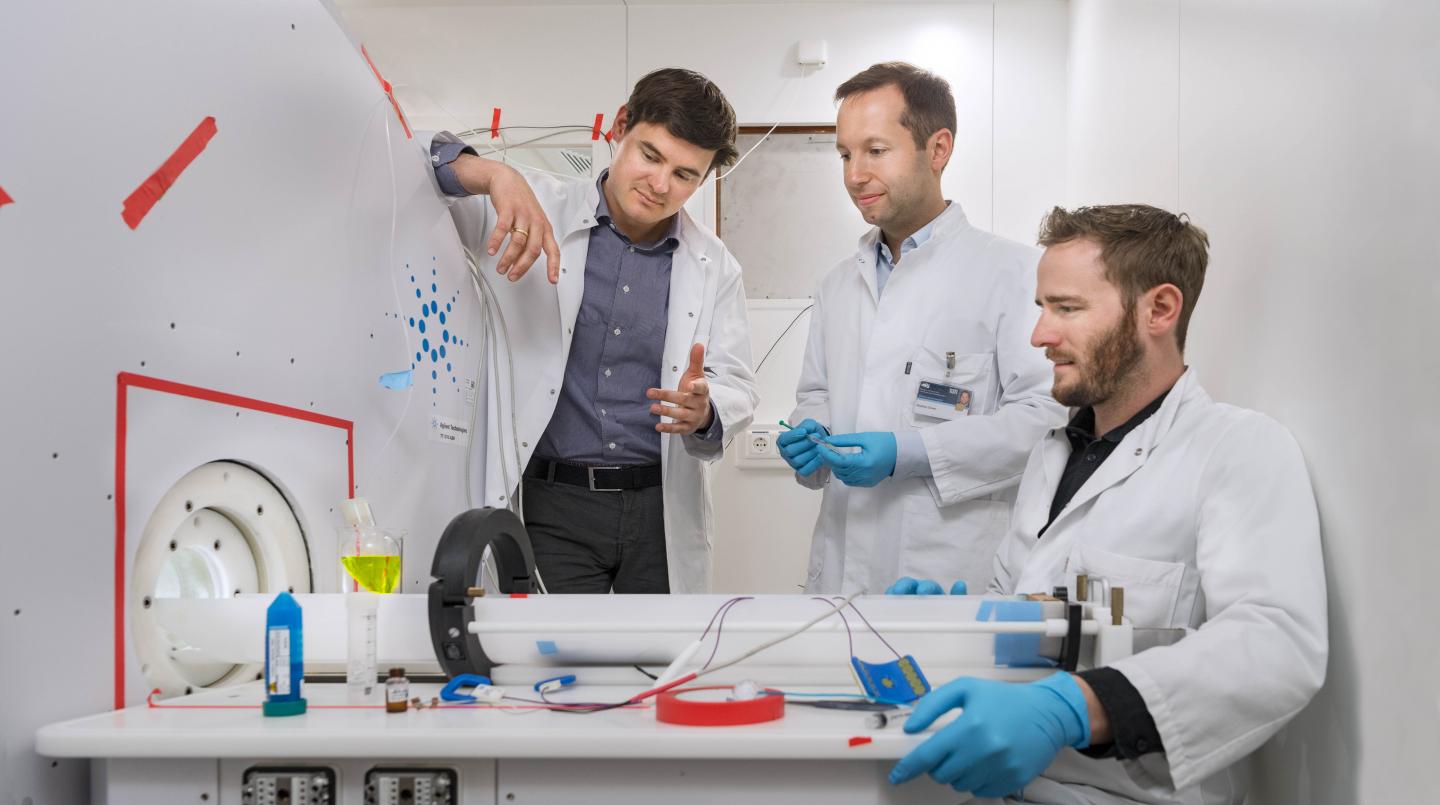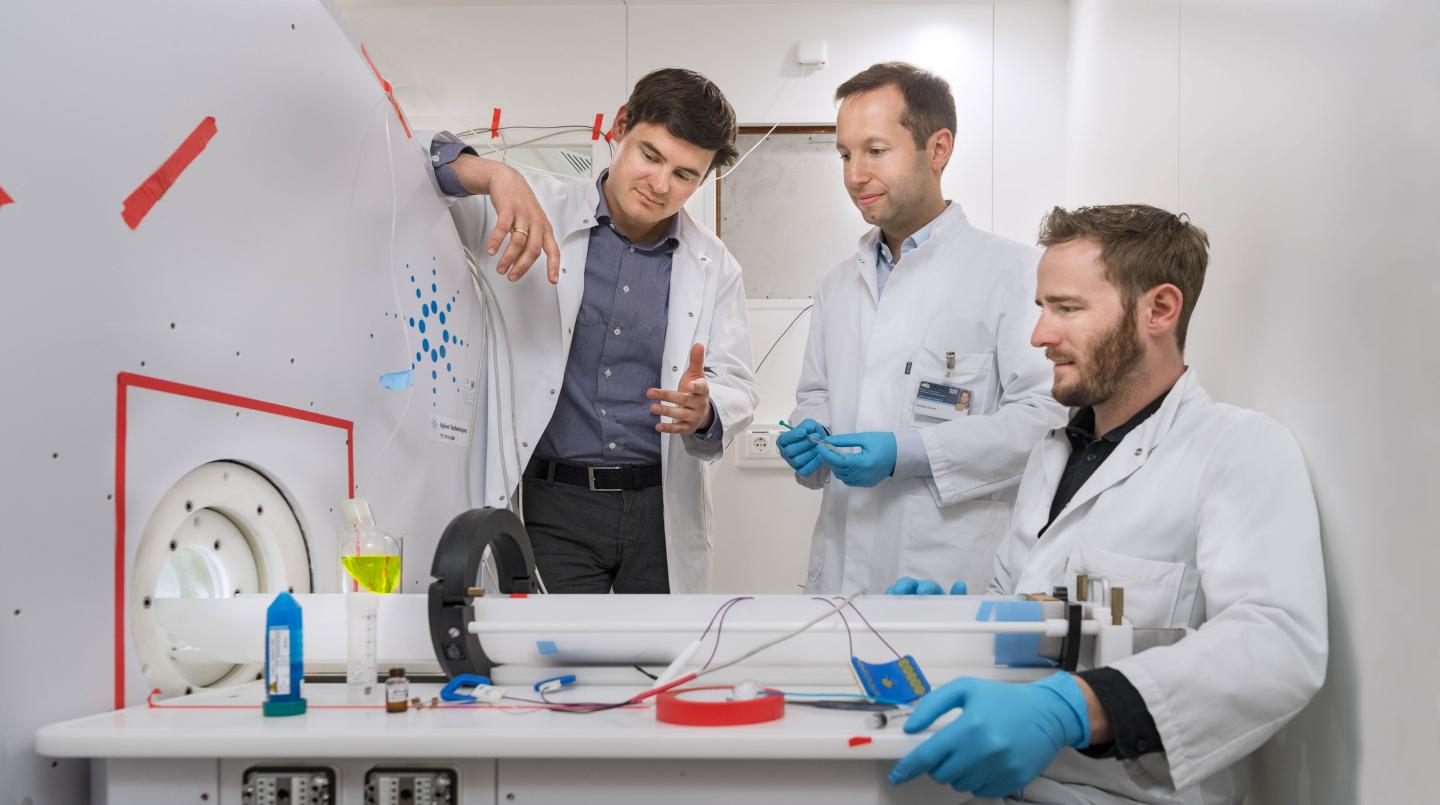
Credit: Andreas Heddergott / Technical University of Munich
Tumors, inflammation and circulatory disorders locally disturb the body's acid-base balance. These changes in pH value could be used for example to verify the success of cancer treatments. Up to now, however, there has been no imaging method to render such changes visible in patients. Now a team from the Technical University of Munich (TUM) has developed a pH sensor that renders pH values visible through magnetic resonance imaging (MRI) – in a non-invasive, radiation-free manner.
Four years ago, during a magnetic resonance experiment with tumor cells, TUM physicist Dr. Franz Schilling found signals from a molecule that was highly sensitive towards pH changes. The molecule, which was identified as zymonic acid in subsequent investigations, could play an important role in the future of medical imaging. As a biosensor for pH values, it could provide insights into the body which had been impossible in the past.
"An appropriate pH imaging method would make it possible to visualize abnormal changes in tissue and specifically metabolic processes of tumors," explains Franz Schilling. Areas surrounding tumors and inflammations are usually slightly more acidic than areas surrounding healthy tissue, a phenomenon possibly linked to the aggressiveness of tumors. Schilling sees further potential uses in treatment prognoses: "pH values are also interesting when it comes to evaluating the efficacy of tumor treatments. Even before a successfully treated tumor starts to shrink, its metabolism and thus the pH value of the surrounding area could change. An appropriate pH imaging method would indicate at a much earlier stage whether or not the right approach has been selected."
Schilling is now Director of the working group for Preclinical Imaging and Medical Physics at the Clinic and Polyclinic for Nuclear Medicine in the TUM Klinikum rechts der Isar. In past years, he has joined together with colleagues from the departments of Physics, Chemistry and Medicine to research zymonic acid as a biosensor. In the journal Nature Communications the team describes how it can be used to reliably represent pH values in the bodies of small animals.
MRI-Imaging with time constraints
In order to make pH values visible using zymonic acid, the molecule is injected into the body and then a magnetic resonance imaging (MRI) investigation is made of the object tissue. In greatly simplified terms: In a strong magnetic field, radiowaves excite the nuclear spins of the zymonic acid to oscillation. The reactions of the nuclei are then recorded. This data is used to calculate frequency spectra that in turn provide information about the chemical properties of the molecular surroundings of the nuclei. Ultimately, the pH value at any examined location in the tissue can be represented based on pH-dependent molecular changes in the zymonic acid.
Zymonic acid has to be marked with carbon 13 in order to be visible in MRI images. This means that the molecules contain carbon 13 atoms (13C) instead of "normal" carbon 12 atoms. But zymonic acid marked in this manner is still not measurable: its MRI signal is too weak. "We therefore use a relatively new method, hyperpolarization," explains Stephan Düwel, physicist and first author of the study. "We use a special device to transfer the polarization of electrons to the 13C atomic nuclei using microwaves at very low temperatures, which results in an MRI signal up to 100,000 times stronger." A hot liquid is then used to quickly return the zymonic acid to room temperature.
After this, the scientists need to act quickly. The biosensor is injected intravenously into the organism, then the MRI scan has to be made immediately: It only takes 60 seconds for the signal-amplifying effect of the hyperpolarization to wear off again. "We're currently working on expanding this time window," says Düwel. "On the one hand, we're trying to improve the MRI properties of zymonic acid with appropriate modifications to the molecule; On the other hand, we're looking for other pH-sensitive molecules," explains biochemist Christian Hundshammer, second author of the study.
Advantages compared to other approaches
Franz Schilling and his team have succeeded in showing that their method is sensitive enough to represent medically relevant pH value changes in the organism. Using zymonic acid it is furthermore possible to specifically investigate the pH value outside of the cell membrane: With other biosensors it is often not clear whether measured changes take place inside or outside of the cell (intracellular or extracellular). This is important because the intracellular value is usually stable, while changes in metabolism have a much greater impact on the extracellular value.
In contrast to optical methods, which are limited to superficial penetration into the body because of the low transparency of tissue, there are no limitations to the depth of penetration for MRI. It has furthermore been demonstrated that zymonic acid is not toxic in the concentrations used with small animals and is also created in low concentrations as a by-product of the metabolite pyruvic acid which is present in the body.
"We believe zymonic acid is a highly promising biosensor for patient applications," says Franz Schilling. For the time being, however, additional pre-clinical studies are planned in order to ascertain the advantages of this new imaging biomarker compared to conventional methods and to further improve the spatial resolution of pH imaging.
###
The research project was funded by the Collaborative Research Centre 824 (SFB824) "Imaging for Selection, Monitoring and Individualization of Cancer Therapies" led by Prof. Markus Schwaiger.
Publications:
S. Düwel, C. Hundshammer, M. Gersch, B. Feuerecker, K. Steiger, A. Buck, A. Walch, A. Haase, S. J. Glaser, M. Schwaiger, F. Schilling, "Imaging of pH in vivo using hyperpolarized 13C-labeled zymonic acid". Nature Communications (2017). Doi: 10.1038/NCOMMS15126
F. Schilling, S. Düwel, U. Köllisch, M. Durst, R.F. Schulte, S.J. Glaser, A. Haase, A.M. Otto, M.I. menzel. "Diffusion of hyperpolarized 13C-metabolites in tumor cell spheroids using real-time NMR spectroscopy". NMR Biomed., 26:5 (2013) 557-568. doi:10.1002/nbm.2892
http://onlinelibrary.wiley.com/doi/10.1002/nbm.2892/abstract
Further Information:
Dr: Franz Schilling: http://www.sfb824.de/de/Team/Mitarbeiter/members/Schillin_Franz/index.php
Chairs involved:
Prof. Dr. Steffen J. Glaser, Professor for Organic Chemistry http://www.professoren.tum.de/en/glaser-steffen/ Prof. Dr. Markus Schwaiger, Professor for Nuclear Medicine http://www.professoren.tum.de/en/schwaiger-markus/ Prof. Dr. Axel Haase, Biomedical Engineering http://www.ph.tum.de/about/people/vcard/90A1916EC27D45EA/
Contact:
Dr. rer. nat. Franz Schilling
Director of Preclinical Imaging
Klinik und Poliklinik für Nuklearmedizin
Klinikum rechts der Isar
Technical University of Munich
Tel: +49 (0) 89 4140 4586
[email protected]
High-Resolution Images: https://mediatum.ub.tum.de/1360445
Media Contact
Paul Hellmich
[email protected]
49-892-892-3325
@TU_Muenchen
http://www.tum.de
Original Source
https://www.tum.de/en/about-tum/news/press-releases/detail/article/33862/ http://dx.doi.org/10.1038/NCOMMS15126





